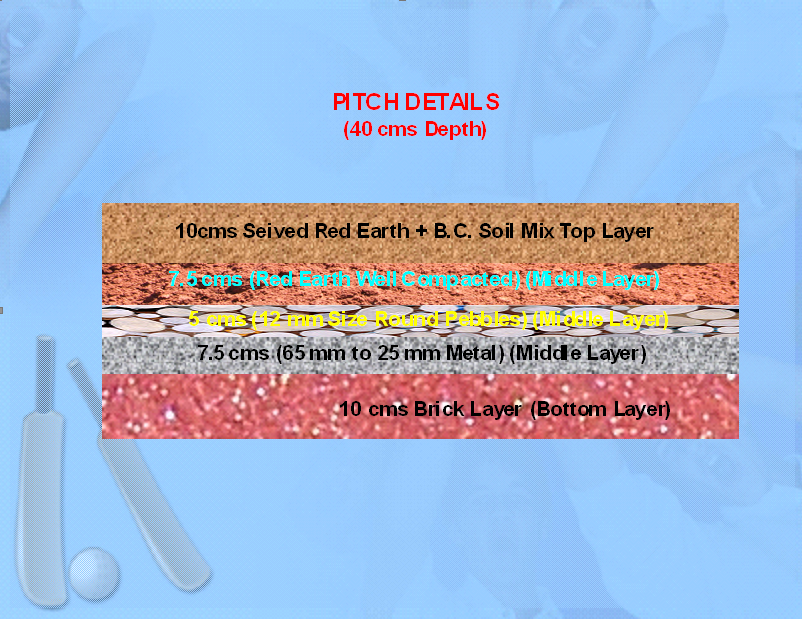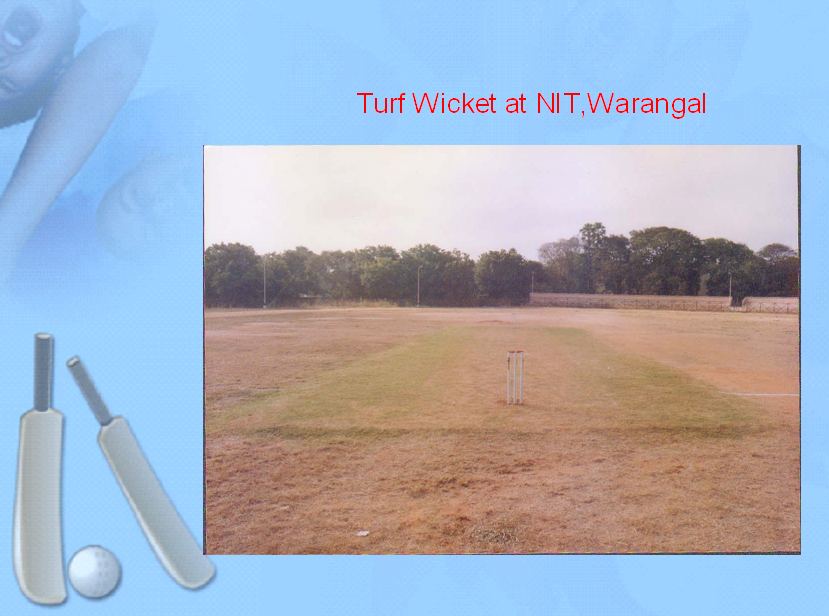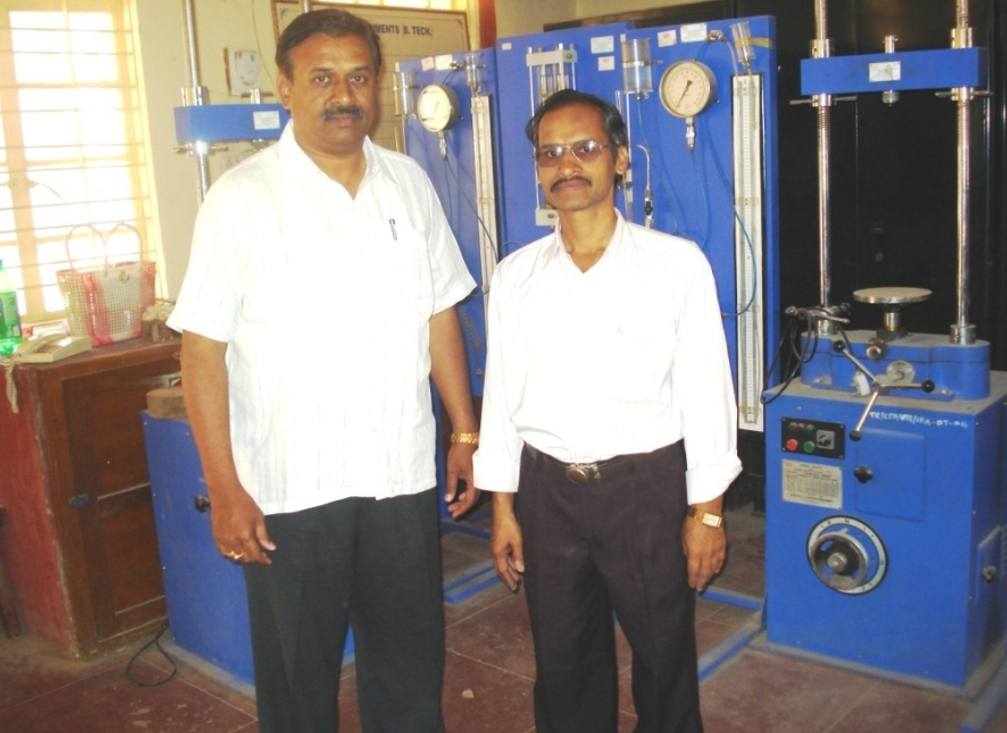CRICKET PITCH PRINCIPLES AND PRACTICE OF PITCH PREPARATION
Download PDF
• Keeping in view the limitations of the adopted practices for pitch preparation, an attempt is made to use the fundamental concepts from the modern soil mechanics.
• The science of soil mechanics indicates that the soils having finer content (-75u size)of around 30% with liquid limit 30-35%, is suitable for a wide range of applications without much compromising on the strength aspects.
• Such soils also maintain better drainage while supporting the growth of grass.
• The cricket pitches at NIT Warangal were prepared by using artificially mixed soils using two locally available soils in such a way that the mix derives the beneficial properties from both the individual soils.
• Trail mixes of black cotton soil and red soil were made in different proportions and their index and compaction properties were determined.(Table:1) Soil balls were made and sun dried in order to observe the degree of cracking.
Cricket Pitch Principles and practice of pitch preparation
- Ravi Kumar* Ramana Murthy**
* Professor of Physical Education, NIT, Warangal-506 004, (TS)
** Professor, Dept. of Geo Tech Engineering, NIT, Warangal-506 004, (TS)
Introduction
Present Attempt:
- Keeping in view the limitations of the adopted practices for pitch preparation, an attempt is made to use the fundamental concepts from the modern soil mechanics.
- The science of soil mechanics indicates that the soils having finer content (-75u size)of around 30% with liquid limit 30-35%, is suitable for a wide range of applications without much compromising on the strength aspects.
- Such soils also maintain better drainage while supporting the growth of grass.
- The cricket pitches at NIT Warangal were prepared by using artificially mixed soils using two locally available soils in such a way that the mix derives the beneficial properties from both the individual soils.
- Trail mixes of black cotton soil and red soil were made in different proportions and their index and compaction properties were determined.(Table:1) Soil balls were made and sun dried in order to observe the degree of cracking.
|
Properties |
Soil Mixes |
|||
|
Black Cotton Soil |
Red Soil |
70% Red Soil + 30% B.C. Soil |
50% Red Soil + 50% B.C. Soil |
|
|
Grain Size Distribution Gravel (%) Sand(%) Silt + Clay (%) |
0 34 66 |
0 76 24 |
0 64 36 |
0 56 44 |
|
Atterberg Limits Liquid Limit (%) Plastic Limit (%) Shrinkage Limit (%) |
68 24 12 |
29 18 17 |
37 17 16 |
47 22 14 |
|
I.S. Soil Classification |
CH (Highly Plastic Clay) |
SC (Clayey Sand) |
SC |
SC |
|
Compaction properties Optimum Moisture (OMC)content(%) Maximum Dry Density(MDD) (g/cc) |
20 1.62 |
13 1.78 |
15 1.74 |
16 1.70 |
Table – 1
Properties of Soil Mixes
CONSTRUCTION OF CRICKET PITCH
- Trial Sections : Trial sections of different soil composition were constructed before finalising the test pitch. Five trail sections of size 1.5 x 2 m were constructed using the top soil covers of B.C. Soil, Red Soil, 70% Red Soil +30% B.C. Soil; 50% Red Soil + 50% B.C. Soil and 70% B.C Soil+30%Red Soil respectively.
- These sections were tested for their moisture retention, drainage, grass growth, crack growth, bouncing, and sustainability characteristics. Though the grass could grow on all combinations, B.C. Soil could retain higher moisture content for relatively longer time period.
- However, the surface remains sticky even with little watering. Red Soil has shown almost the opposite behaviour. The combination of 50% B.C. + 50% Red Soil has shown higher degree of shrinkage cracks, though other properties were favourable.
- The mix of 70% Red Soil + 30% B.C. Soil, on the other hand, has shown the favourable properties of moderate shrinkage cracks, good drainage, workable surface even after wetting while supporting good grass growth.
CONSTRUCTION OF FINAL TEST SECTION
- The final test section is of size 25’x 75’ was constructed with the cross section shown in Fig.1. A 40cm depth of trench of size 25’ x 75’ was excavated and the sub-grade was compacted using a roller. Over the compacted sub-grade, 10 cm thick brick powder was placed and compacted by suitable water content. Then a metal layer of 12.5 cm thickness using 65 mm and 12 mm size aggregate was laid and compacted. The above layers of brick powder and metal facilitate good subsurface drainage while giving stability. Over the metal layer, 7.5 cm thick red earth was compacted to its maximum dry density at its optimum moisture content of 13%. The top 10 cm thick layer consists of 70% red soil + 30% B.C. soil blended mix was compacted to its maximum dry density at its optimum moisture content of 15%.Subsequently, grass was grown over the finished surface (plate).
- The mix of 70% red soil + 30% B.C. soil has resulted in a favourable combination having the properties conductive for strength, moisture retention for grass growth and little to moderate shrinkage cracking.
- These theoretical aspects were further verified by making few balls of soil mixes and allowing them to dry under sun.
- The moisture content of test balls is kept at their plastic limit water contents to facilitate ball making by remoulding and the balls and were shaken on the palms until their surface becomes smooth.
- Then these balls were kept under sun to allow them dry and observations were made with regard to their degree of cracking .
- It can be observed that the red soil balls are almost free from shrinkage cracking (plate) while black cotton soil balls have shown severe cracking (plate).
- The degree of shrinkage cracking of clay balls is observed to be decreasing with the addition of red soil to it.
- For 50% red soil + 50% clay also surface cracks are observed. However balls with 70% red soil + 30% B.C. soil have shown only micro-cracks, confirming the theoretical aspects of this mix based on the index properties as shown in table – 1
Conclusions
- It is a fundamental principle that you cannot play good cricket on poor wickets.
- 50 %to 70% of black cotton soil is traditionally used for the preparation of top layer of the turf wicket without any scientific basis.
- On the basis of the research undertaken it was proved that the top 10 cm thick layer consists of 70% red soil + 30% B.C. soil blended mix was compacted to its maximum dry density at its optimum moisture content of 15%.
- Subsequently, locally available grass was grown over the finished surface.
- It is thought fit to upgrade the knowledge available to Physical Educationist, Coaches and Cricket administrators for the preparation of turf wickets that too with limited budget and with simple and most scientific way.




















